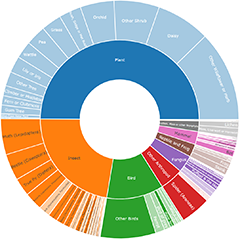Announcements
12 Oct 2025
Following a review of our operations, we have made the difficult decision to wind down.Please see our platform transition guide for specific sunset dates as we now ensure our users are well supported ...
Continue reading
Known issue affecting NatureMapr Data Collector mobile app
NatureMapr moves to simpler, flatter national structure
Mobile App update and known issues
Discussion
Jennybach
wrote:
5 min ago
I’ve heard it a lot in casuarina. Now I can finally see it. Thanks Michael
Lalage tricolor
wombey
wrote:
25 min ago
Difficult to tell from these images but the neck seems a little short for longicollis?
Emydura macquarii
Tapirlord
wrote:
42 min ago
Flower structure and leaf shape suggests G.tabacina unfortunately
Glycine tabacina
TimL
wrote:
1 hr ago
Thanks @WendyEM As you say, these are tiny wasps and usually very active, so the process is to use a fast shutter speed together with diffused flash which usually produces sharp, bright, evenly lit images. To get most of the wasp into focus it also helps to use an aperture size that gives a depth of field appropriate for the wasp's size and to try and take the images looking straight on at the wasp either from the side or from above such that the insect falls within the depth of field. Makes all the difference. NatureMapr's DSLR photography guide provides some advice on this subject. Hope this helps. Tim
Torymidae (family)
Heinol
wrote:
1 hr ago
Yesterday afternoon I collected what may be the same fungus as yours – numerous tiny, firm brown lumps with powdery spores that are easily picked by a finger rubbed over a lump. They were on some exposed, well-weathered but still-hard wood in my yard. This morning an identification key to asexual forms quickly brought me to the genus Coniosporium. Also on my wood, intermingled with the brown lumps, were a number of fruitbodies of possibly the species Oedohysterium insidens – the fruitbody of which looks like a pair of tiny black lips, about a millimetre or so long. You can see the black lips of another Oedoysterium species here: https://canberra.naturemapr.org/sightings/3379086. The black lips of Oedoysterium insidens produce sexual spores and the same species produces asexual spores in a powdery brown lump that has been assigned to the genus Coniosporium. It is a basic principle of biological naming that a given species should have only one name – so how can a fungus have one species name in the genus Oedohysterium and another species name in the genus Coniosporium? Black lips and powdery brown lumps are visually quite different, with nothing to suggest a connection between the two. In the 1800s fungi were named on the basis of visual features and, especially in the later 1800s, with the help of a microscope. An 1800s mycologist who looked, macroscopically and microscopically, at the black lips and the brown lump would see that they were dramatically different down to the microscopic level and would naturally assign them to different genera. Just because brown lumps and black lips grow together doesn’t prove that there is a connection. In the later 1800s people did begin to establish sexual-asexual connections by growing fungi in culture in labs and showing that, say, a sexual spore could germinate and the growing fungus could produce an asexual form. Nowadays such connections are also produced by molecular analyses. Getting back to Oedoysterium insidens and brown lumps, whereas in the old days such a lump would have been identified as a species of Coniosporium what people would say today is that the brown lump is the Coniosporium state of Oedohysterium insidens.
Your photos are a little blurry and I cannot tell whether any black lips are present or not. There are several other genera of such ‘black lips’ fungi, macroscopically similar and where identification depends on features of the sexual spores. Some years ago I collected a specimen of a different genus but one where similar ‘Coniopsorium’ lumps were present with the black lips. So, though I suspect that your fungus is a ‘Coniosporium’, I cannot say which black lips genus it might be associated with.
Your photos are a little blurry and I cannot tell whether any black lips are present or not. There are several other genera of such ‘black lips’ fungi, macroscopically similar and where identification depends on features of the sexual spores. Some years ago I collected a specimen of a different genus but one where similar ‘Coniopsorium’ lumps were present with the black lips. So, though I suspect that your fungus is a ‘Coniosporium’, I cannot say which black lips genus it might be associated with.
zzz puzzles on wood
Significant sightings
- Anthophiloptera dryas at Laguna, NSW
- Diuris aurea at Bango, NSW
- Paraspania discors at O'Connor, ACT
- Swainsona recta
- Scolecobrotus variegatus at Reid, ACT
- Caladenia montana at Cotter River, ACT
- Grevillea iaspicula
- Candalides xanthospilos at Jerrabomberra, NSW
- Mordellistena (genus) at Campbell, ACT
- Diuris punctata
Top contributors
- AlisonMilton 18.1K
- Hejor1 16.4K
- trevorpreston 16.3K
- Tapirlord 12.1K
- Mike 11.2K
- MichaelBedingfield 10.9K
- RodDeb 10.6K
- ConBoekel 9.9K
- kasiaaus 9.9K
- KylieWaldon 9.2K
Top moderators
- MichaelMulvaney 62.4K
- Tapirlord 42.5K
- MichaelBedingfield 24.3K
- Liam.m 22.4K
- donhe 18.3K
- ibaird 15.8K
- natureguy 15.7K
- MatthewFrawley 12.5K
- AlisonMilton 11.3K
- plants 9.1K















































































































